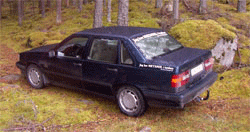![]() ABOUT METHANOL/OM METANOL
ABOUT METHANOL/OM METANOL
Methanol as Transportation Fuel
Methanol as a key chemical building block
- A superior high octane fuel (105 octane)
- A sustainable, domestic and climate neutral energy source
- Greenhouse gas savings exceed other liquid bio-fuels by far, 80-90% in comparison to 15-40% for agro-based ethanol.
- Fuel properties are excellent due to the high octane rating
- It burns with very clean fumes and can be used in spark ignition port injected gasoline engines blended with gasoline (up to 25%) without any modification.
- So-called flexi fuel vehicles (FFVs) made for E85 can also run on high methanol blends, such as M85.
- The cars of tomorrow will have electric motors powered by fuel cells - bioMethanol is the most cost-efficient and environmental friendly liquid fuel for fuel cell vehicles. Methanol can be directly fed into a fuel cell without being reformed into hydrogen.
- BioMethanol can be introduced on the market by using present distribution systems without additional costs.
 |
VärmlandsMetanol has during 8 years without problems driven a Volvo 850 of model 1992 with different methanol admixtures. The car has been running excellently without any adaptions for more than 68 850 kilometers with different methanol blends in gasoline. |
|---|
 |
Speedway motorbikes needs a high octane fuel. That is why they use pure methanol. In the USA american Formula 1 cars also has been driven on pure methanol. During the 1980-ties the state of Califonia had approximately 14 000 cars driven on M85, dvs 85 percent methanol and 15 percent gasoline. |
|---|
Preem om Metanol:
“Another alternative motor fuel is methanol, which commonly is referred to as wood alcohol. Just as ethanol it is excellent to use
as a low admixture in ordinary petrol. Another advantage is that it
is cheap to produce from wood biomass. It is difficult to find
disadvantages with using methanol. There is a surplus of biomass feedstock and the infrastructure – the gas stations – already exist”.
Source: Swedish oil company Preem, the Energy Challenge 2010
